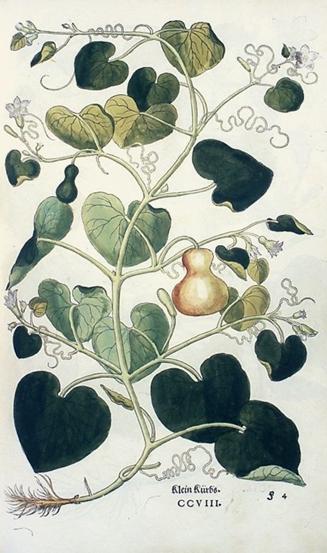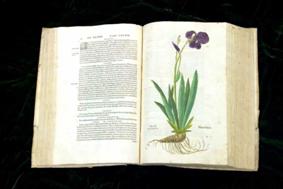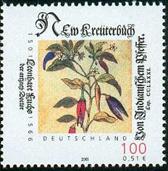Leonhart Fuchs (1501 – 1566)

Fuchs was born in the Duchy of Bavaria in 1501. Initially he was a practising doctor, who went on to become a medical professor in 1526. However, Fuchs is mainly known as the third of the ‘founding fathers’ of Botany, after Otto Brunfels and Jerome Bock. He played a leading part in reforming the University of Tübingen in the spirit of Humanism, where he founded one of the first German botanical gardens, which is presumed to be one of the oldest in the world.
Fuchs’ scientific legacy came in the publication of his book De Historia Stirpium comentarii insignes (or Notable Commentaries on the History of Plants) in 1542. The De Historia Stirpium is part of a long tradition of herbals or books that describe plants and their medicinal uses. Before the sixteenth century, most herbals were based on folk traditions and Greek and Roman texts, not on scientific or artistic observation. Fuchs broke with this tradition by becoming interested in illustrations based upon the appearance of the living plant instead of using conventional (and often bizarrely inaccurate) representations. He included botanical descriptions of the plants giving a reference to their habitat, flowering period and medicinal properties. Although he did not use terms like genus or family, he was aware of the kinship between similar-looking plants. By making detailed comparisons of plant individuals of the same species from different field sites, he laid the basis for modern botany as a scientific subject.
Fuchs hired three professional artists to help him with this undertaking: Albrecht Meyer, who painted the plants in watercolours from life; Heinrich Füllmaurer, who transferred the paintings to woodblocks; and Veit Rudolph Speckle, who cut the blocks and printed the woodcut illustrations. The beautiful, densely illustrated book that resulted from their efforts contains some of the finest pictures of plants from the sixteenth century, many hand-coloured under Fuchs’ supervision for greatest accuracy. De Historia Stirpium is notable among early scientific books for its inclusion of the artists’ names and portraits in the back of the book.

Fuchs’ interest in realistic representations accorded with the Renaissance ideal of naturalism, but it also served a practical purpose – he wanted his book to be a reference for his medical students and fellow doctors. While the images were cutting-edge for their time, Fuchs was not as revolutionary in the text, and his description of each plant’s medicinal properties still draws largely on the writings of Greek and Roman authors such as Dioscorides, Galen and Pliny. Even so, Fuchs did encourage his own students to cultivate and study medicinal plants firsthand. Surviving copies of De Historia Stirpium often contain pressed plant samples, stains, and marginal notes that point to extensive use. In this way, De Historia Stirpium can give modern scholars insight into the ways early physicians studied and administered herbal medicines.De Historia Stirpium features 400 native European species of plants. The book also introduced many Europeans to the unfamiliar fruits, vegetables and plants being imported from the Americas: it contains the first descriptions and illustrations of over 100 domesticated species, including pumpkin, squash, chilli pepper, and maize. It is thought that some of these plants were drawn from specimens or seeds Fuchs acquired and grew in his own garden.
The work, obviously, is not without its faults; Fuchs’ heavy reliance on previous authorities resulted in mistakes. There are several erroneous identifications, Fuchs often misassigning the properties of German plants to those ascribed to Mediterranean plants by Dioscorides. Meanwhile, some species are depicted twice with different names because of mistakes in identification as a result of variation in leaves, flowers or fruits.
Fuchs' name is preserved by the plant Fuchsia, discovered in 1696/97 by the French scientist Dom Charles Plumier, who published the first description of "Fuchsia triphylla, flore coccineo" in 1703. The colour ‘fuchsia’ is also named for him, describing the purplish-red of the shrub's flowers.


References and featured material
- Curators of the University of Missouri: Special Collections and Rare Books;
http://mulibraries.missouri.edu/specialcollections/fuchs.htm
- Universitätsbibliothek Tübingen;
http://tobias-lib.uni-tuebingen.de/volltexte/2001/237/html/lo-res/tn/fuchs378.jpg.html
(complete scan of De Historia Stirpium)
- Manfred Ebener: Kleines Lexikon zur Geschichte in Baden und Württemberg/Südwestdeutschland;
http://www.s-line.de/homepages/ebener/index.htm
- Glasgow University Library: Special Collection Department;
http://special.lib.gla.ac.uk/exhibns/month/oct2002.html